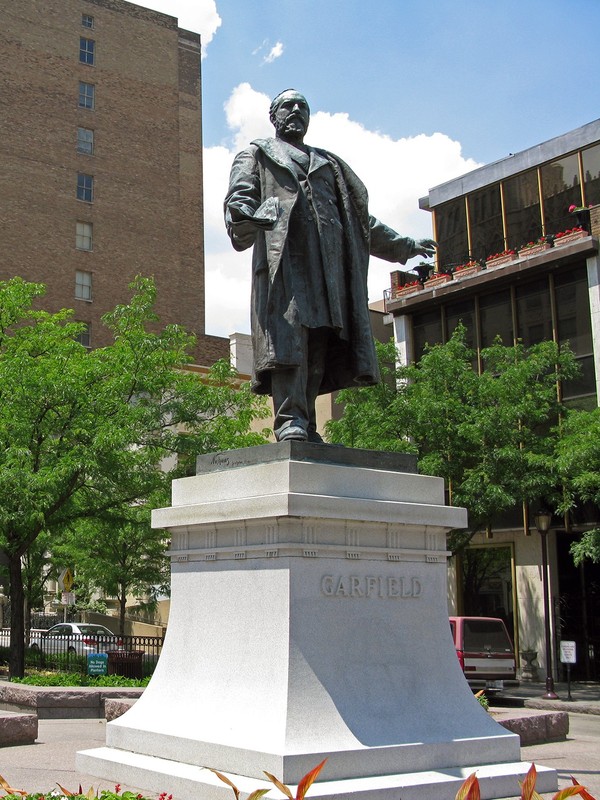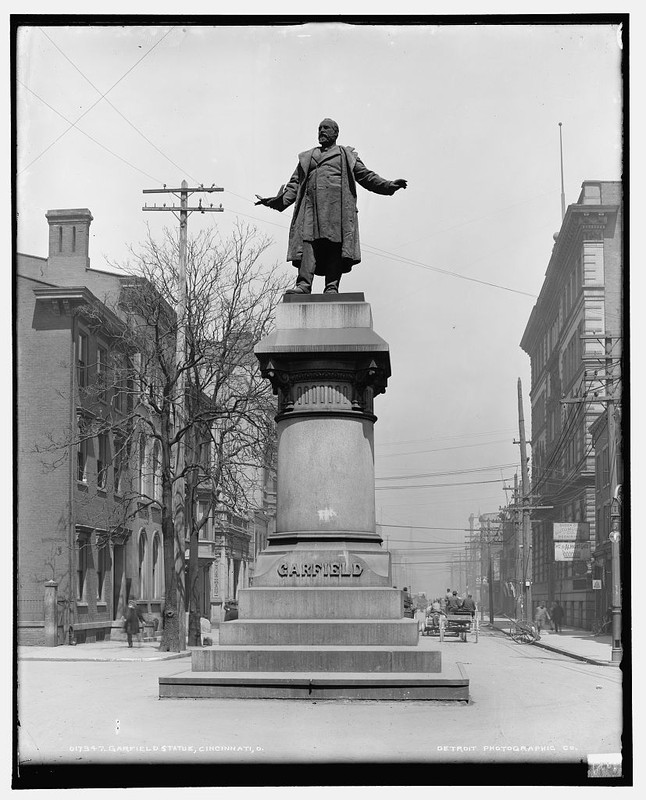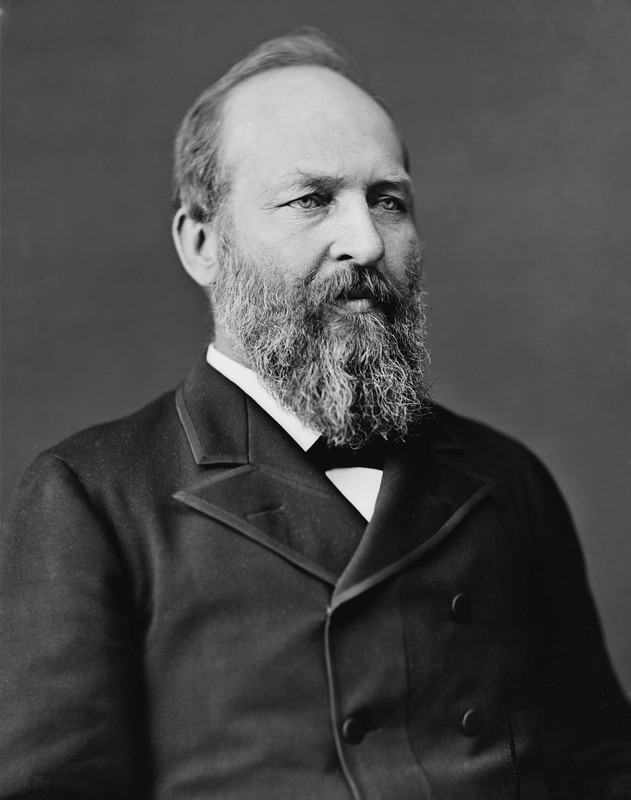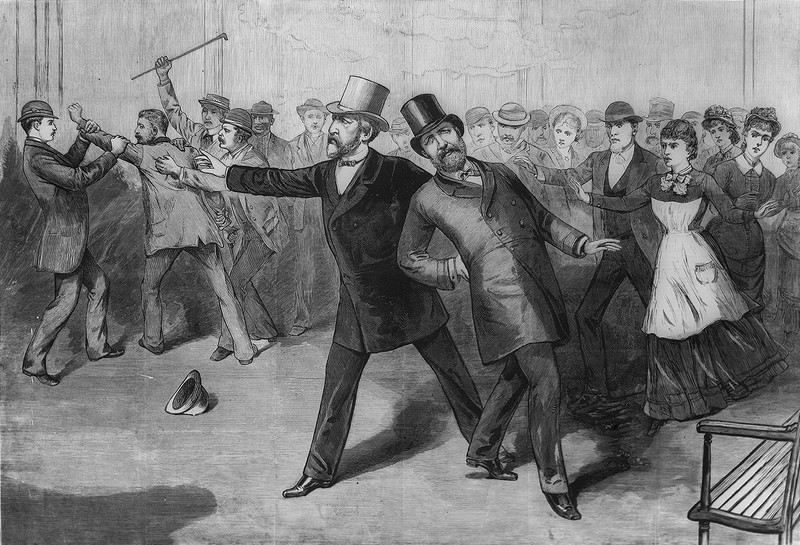James A. Garfield Statue
Introduction
Text-to-speech Audio
Unveiled on December 1, 1887, this monument commemorates the twentieth President of the United States, James A. Garfield (1831-1881). A native of Ohio and U.S. Army general during the Civil War, he served for nine terms in the U.S House of Representatives as a Republican before being elected president in 1881. Less than four months after his inauguration, on July 2, 1881, Garfield was shot twice by Charles Guiteau, a disgruntled officer seeker, while waiting at a train station in Washington, D.C. For several weeks, he languished in pain as doctors unsuccessfully searched for one of the projectiles. Riddled with infection from the countless unsterile examinations, he passed away on September 19. In the wake of Garfield’s death, the City of Cincinnati moved to erect a statue of him in the city, and in 1883 commissioned Cincinnati-born sculptor Charles Henry Niehaus to design it. Paid for by public subscriptions, the bronze statue depicts Garfield standing, dressed in a suit and overcoat. Holding a stack of papers in his right hand and gesturing with his left, he looks out onto the horizon as if about to deliver a speech. Originally, the sculpture rested on a tall pedestal in the middle of the intersection of Eighth and Race Streets. After nearly three decades of frustrating motorist and buggy drivers, the statue was moved inside Eighth Street Park (now Piatt Park), a short distance from the intersection, and placed on a new, shorter pedestal. In 1988, when the park underwent renovations, the statue was moved to its current location at the park’s Vine Street end.
Images
James A. Garfield Statue in Cincinnati's Piatt Park

The bronze statue on its original pedestal in its original location in the middle of the intersection of Eighth and Race Streets (c. 1900-1906)

James A. Garfield (1831-1881)

A contemporary engraving depicting Garfield's assassination

Backstory and Context
Text-to-speech Audio
James Abram Garfield was born in a log cabin on November 19, 1831 in Cuyahoga County, Ohio. Before his second birthday, his father died, forcing his mother to not only raise him and his siblings, but also manage the small, struggling family farm. A bright child, Garfield escaped his harsh reality by reading voraciously. Initially yearning to become a sailor and travel the world, he settled for a job as a mule team driver on the Ohio and Erie Canal. Somehow, Garfield scraped together enough money to enroll at Western Reserve Eclectic Institute (now Hiram College). After two years there, he attended Williams College in Massachusetts, graduating in 1856. Garfield then returned to Western Reserve Eclectic Institute to become a professor of classical languages. Only a year later, at the age of twenty-five, he became the school’s president. A member of the newly formed Republican Party, Garfield won a seat in the Ohio legislature in 1859. When southern slaveholding states began to secede, he advocated for the use of force to preserve the Union.
Following the outbreak of the Civil War, Garfield received a commission as a colonel and helped organize the Forty-Second Ohio Infantry. Early in the conflict, he saw combat in eastern Kentucky and at the Siege of Corinth and the Battle of Shiloh. In the fall of 1862, Garfield was elected to the U.S. House of Representatives. Initially hesitant to resign his commission, he required some convincing. Garfield received it from none other than President Abraham Lincoln, who thought highly of him and was in search of effective Republicans in Congress. Before taking office, however, he became Chief of Staff for Major General William S. Rosecrans, commander of the Army of the Cumberland, and participated in the Battle of Chickamauga in September 1863. Later that year, he left the U.S. Army at the rank of major general.
Unlike his tenure in the military, Garfield’s time in Congress was lengthy. He won reelection eight times, serving for a total of eighteen years on Capitol Hill, eventually becoming the leading Republican in the U.S. House of Representatives. In 1880, the Ohio legislature elected him to the U.S. Senate, but Garfield never took his seat. That same year, the Republican Party selected him as their nominee for President of the United States. In the fall, Garfield won a close election, defeating Democratic nominee Winfield Scott Hancock, who also served as a U.S. Army general during the Civil War. Less than four months after his inauguration, on July 2, 1881, he was shot twice by Charles Guiteau, a disgruntled officer seeker, while waiting at a train station in Washington, D.C. The first bullet merely grazed Garfield, but the second penetrated his back and lodged itself deep within his abdomen, settling behind his pancreas. For several weeks, Garfield languished in pain as doctors unsuccessfully searched for the projectile. Riddled with infection from the countless unsterile examinations, he passed away on September 19 at the age of forty-nine. He was buried in Cleveland’s Lake View Cemetery.
In the wake of Garfield’s death, the City of Cincinnati moved to erect a statue of him in the city, and in 1883 commissioned Cincinnati-born sculptor Charles Henry Niehaus to design it. Unveiled on December 1, 1887 and paid for by public subscriptions, the bronze statue depicts Garfield standing, dressed in a suit and overcoat. Holding a stack of papers in his right hand and gesturing with his left, he looks out onto the horizon as if about to deliver a speech. Originally, the sculpture rested on a tall pedestal in the middle of the intersection of Eighth and Race Streets. After nearly three decades of frustrating motorist and buggy drivers, the statue was moved inside Eighth Street Park (now Piatt Park), a short distance from the intersection, and placed on a new, shorter pedestal. In 1988, when the park underwent renovations, the statue was moved to its current location at the park’s Vine Street end.
Sources
Freidel, Frank and Hugh S. Sidey. The Presidents of the United States of America. Washington, DC: White House Historical Association, 2006.
History.com Editors. "James A. Garfield" History. A&E Television Networks. 10 June 2019. Web. 27 June 2021 <https://www.history.com/topics/us-presidents/james-a-garfield>.
Suess, Jeff. "President statues tell our story." Cincinnati Enquirer, February 16, 2020 <https://www.cincinnati.com/story/news/2020/02/16/president-statues-lincoln-taft-garfield-harrison-cincinnati/4763028002/>.
Workers of the Writers' Program of the Works Progress Administration in the State of Ohio. Cincinnati: A Guide to the Queen City and Its Neighbors. Cincinnati: The Wiesel-Hart Press, 1943.
https://en.wikipedia.org/wiki/James_A._Garfield_(Niehaus)
https://www.loc.gov/item/2016803763/
https://en.wikipedia.org/wiki/James_A._Garfield
https://en.wikipedia.org/wiki/James_A._Garfield
